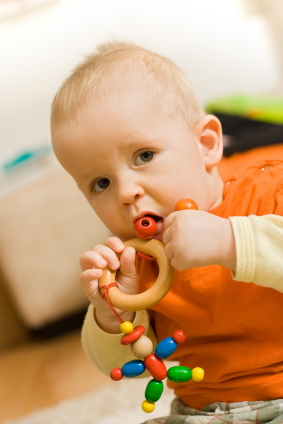Toy safety has been a hot topic recently, especially plastic toys imported from places like China. Some toys contain toxic ingredients such as lead, cadmium, chlorine, arsenic, bromine, mercury, chromium, tin and antimony. Children are much more sensitive to the effects of harmful chemicals, and babies especially tend to put things in their mouths. So, it is important that the toys we give our children are free of toxins. Two of the most common toxins found in children’s products are phthalates and lead. Phthalates have been classified as carcinogenic by the EPA, and lead has been classified as a potent neurotoxin by the CDC.

Plastic is the most popular choice of material for conventional toys. All types of plastic contain some harmful ingredients, so it is good idea to avoid them as much as possible. Some plastics are more dangerous than others and contain toxins such as PVC and phthalates (see article on Plastics).
Electronic toys have similar health and environmental concerns. Electronic usually means plastic is involved so you have all of the same concerns as plastic toys. They may also contain toxic metals and chemical flame retardants. In addition, used batteries end up in landfills, and the manufacture of batteries introduces a host of pollutants into the environment. Once the electronics in a toy stop working, you can’t use it anymore; unlike a wooden or cloth toy which can last indefinitely.
Consumer Product Safety Improvement Act
In 2008, Congress passed the Consumer Product Safety Improvement Act (CPSIA) in an attempt to make products for kids safer. The law gives the Consumer Product Safety Commission (CPSC) more authority and more money to regulate children’s products. It stipulates that children’s products sold in the United States cannot contain more than a miniscule amount of lead or any of three types of phthalates. The law further stipulates that three other types of phthalates will be banned temporarily in order to further study them. Furthermore, manufacturers must submit all children’s products for independent testing before they go to market.
While the CPSIA sounds like a great idea, manufacturers of children’s products and parent groups are actually speaking out against the Act. Their argument is that it is too costly to require manufacturers to put all of their products through rigorous testing and that the price of toys will increase. Another ironic result is that many small businesses that focus on making handmade, all-natural toys will not be able to afford to test their products and will end up going out of business. For more information, visit the CPSC website.
Alternatives to Plastic
If you don’t feel comfortable giving your child plastic toys, there are plenty of other options available, including toys made of wood, cloth, and silicone.
- Wood toys can be a durable and natural alternative. However, not all wooden toys are created equal. Conventional wooden toys are constructed of plywood or particleboard which use toxic glues and toxic finishes that can off-gas VOCs and formaldehyde. Look for toys constructed from solid FSC-certified wood and non-toxic paint or finishes (such as milk paint, beeswax or non-toxic oil).
- Cloth toys vary as well. Conventional cloth toys are made from synthetic materials derived from petrochemicals with ingredients that can cause allergies and disruption of the immune and reproductive systems. Conventional cloth toys sometimes use toxic dyes and stain-resistant treatments. The fillings of conventional toys are usually polyurethane. When purchasing a cloth toy, check with the manufacturer to find out what it is made out of. Choose cloth toys made from a natural fabric, such as organic cotton, wool, leather, hemp or linen. There are also toys constructed of reused materials such as old sweaters and blankets. And make sure the filling is natural as well, for example organic cotton, wool or natural latex foam.
- Silicone is another safer choice. This material is most commonly used for infant teethers, pacifiers and bottle nipples.
- Buying well-made toys that will last is not only good for the environment but also on your wallet. Furthermore, if you purchase handcrafted artisanal toys, you may be supporting local artists and toymakers.
- Try everyday household items instead of buying toys. Pots and pans make great musical instruments. Give your child several cups full of colored water and let them mix the different colors together. Shaving cream can be molded into mountains and trees.
The website, www.healthystuff.org, lists test results for toxic chemicals for more than 2,200 toys and children’s products. If you want information about toys that have been recalled, visit the Consumer Product Safety Commission’s website.
